There’s a natural drive in industry to develop bigger and better equipment, and the wind industry is no different. Even the government through the U.S. Department of Energy is funding research for larger wind turbine blades (over 60 meters) that can work on larger turbines to capture more energy.
Today’s global wind turbine O&M market shows a year-over-year growth rate of 25.8%, according to an analysis by Research and Markets. By 2018, the market size is expected to reach $13.78 billion, which means wind turbines are likely to last longer than ever before.
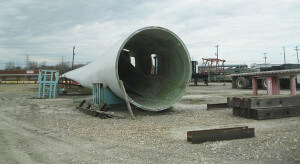
A decommissioned turbine blade. (Source: WSU)
A 2014 study from the UK supported this statement. Researchers examined more than 500 wind farms and found that older turbines (built in the 1990s) were still producing three-quarters of their original output 19 years later. They concluded that most turbines should last longer than expected and about 25 years before needing an upgrade.
Although this is good news, we all know that at some point even good things must come to an end. While driving the wind industry forward is key to reaping continued clean-energy benefits, it’s also worth considering those maturing turbines in the field — and what to do after their expiry date. The number of decommissioned turbines worldwide remains fairly low, but that number is rising because of an aging fleet.
Fortunately, most wind-turbine parts, including the foundation, tower, and components of the gearbox and generator, are recyclable. But turbine blades are another story because of their composition.
Most turbine blades are made from composites, materials joined for their complementary properties. Today’s wind-turbine blades are usually made of a glass or carbon fiber reinforcement in a polymer matrix. The composite is designed for optimal aerodynamic performance and lightweight durability. It is not designed for recyclability.
The concern with this is noted in a research paper by global wind-service provider, DEWI, and quoted again in an abstract published Cambridge University and posted on the European Wind Energy Association website:
“Every kilowatt of wind power requires 10-kg WT blade materials, so predicted there will be nearly 50,000 tons of blade waste in 2020 rising to 200,000 tons in 2034. Currently, most waste is sent to landfill, which is not an environmentally desirable solution.” (Albers 2009)
A study commissioned by Scottish Natural Heritage in 2013 forecast a much higher number, predicting that 225,000 tons of rotor-blade material globally would need disposing of each year.
For an industry that prides itself on clean energy, these aren’t promising statistics. And particularly in countries like Germany where EU regulations prohibit sending decommissioned wind-turbine blades to landfills altogether.
But the wind industry isn’t sitting idle. Concerns over old blades have led to some innovative attempts to reduce turbine waste.
Here are a few examples:
Modern architecture
Back in 2012, the Netherlands led the charge and retired some turbine blades into play structures at children’s parks.
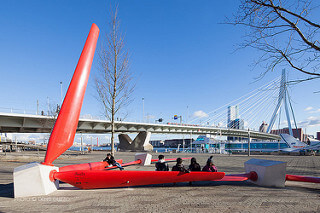
Public seating in the Netherlands, courtesy of recycled turbine blades.
Today, Dutch design firm Superuse Studios has taken this a step further by incorporating blades in city architecture (think public seating) and as outdoor refuge (think bus shelters).
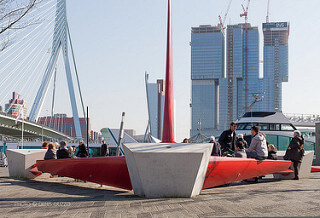
Photos by Denis Guzzo | Superuse Studios
As per their website, Superuse Studios has also been invited to partner with the Danish Genvind Consortium, which is a consortium of over 20 organizations including large turbine manufacturer, Vestas. The main goal of this consortium is to find solutions to the waste generated by wind turbines.
Material matters
In a research project called “DreamWind,” a team of scientists at Aarhus University in Denmark is in the midst of developing a chemical substance that will make it possible to separate composite materials from each other — the main problem in recycling turbine blades.
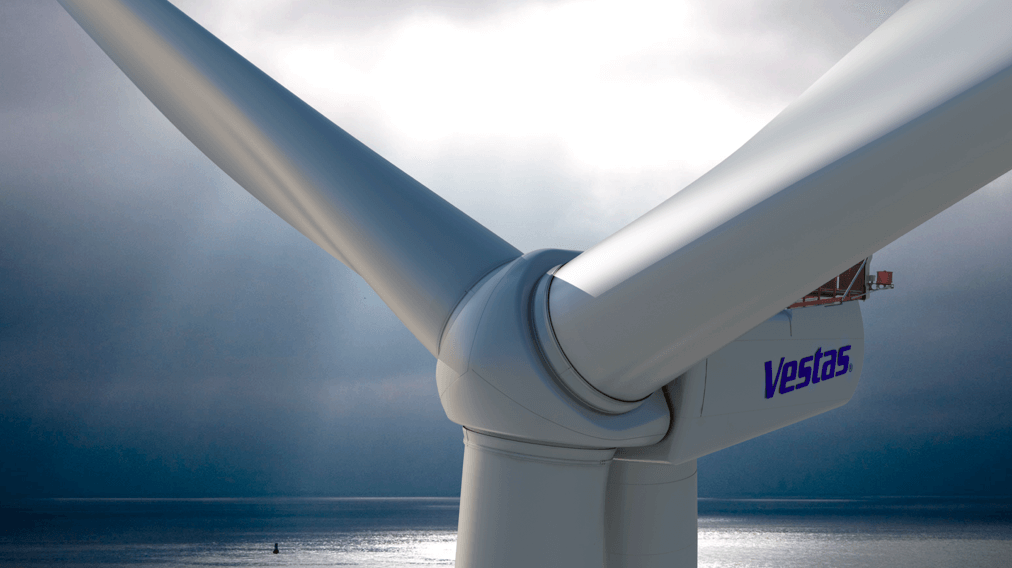
What do you do with outdated wind-turbine blades made of expensive fiberglass? In the future, you add a chemical substance that can separate the glass from the plastic fibers so they can be recycled.
The goal is to develop a solvent with opposite properties, so instead of binding materials to each other, it can separate them chemically with limited or no heating at all. This means large and expensive fiberglass components used in turbine blades could become more easily recyclable in the future.
“Components made of fiberglass have to go through a difficult procedure before they can be reused,” shared the University’s Associate Professor, Mogens Hinge, in a recent press statement. “This entails separating the glass from the plastic, and you can only do this if you heat the material for a long time at 600 degrees Celsius, which is far from profitable — from both an energy and an economic point of view.”
So, the researchers are focusing on developing an agent for fiberglass. The idea is that the glass is worth reusing once separated and cleaned for new fibreglass components for structures such as wind turbines, aircraft, or cars.
“This way, we can retain the value of the material instead of just discarding it,” said Hinge.
Cutting blades (down to size)
Perhaps the answer to recycling turbine blades isn’t in developing new chemicals, but in cutting down the existing blade material.
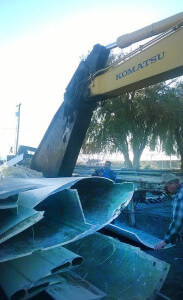
WSU is working with Seattle-based GFS to recycle old turbine blades. The first step is breaking the blades up.
The trick to creating a successful blade-recycling effort, at least according to Karl Englund, Research Associate Professor at Washington State University’s (WSU) Voiland College of Engineering and Architecture, is to keep the process economical and simple.
WSU is currently working with Seattle-based Global Fiberglass Solutions (GFS) to recycle and manufacture composite fiberglass material from decommissioned blades.
According to Englund, fancy thermal or chemical treatments will only raise the cost of recycling. “If you’re going to use a bunch of chemicals or energy to make a product, it’s not going to be worth it,’’ he said in a news article on WSU’s website. “Any added energy, labor, and chemicals will significantly add costs to a material that is already considered a waste product.’’
So, GFS cut down wind turbine blades into palm-size pieces that WSU researchers refined and processed into new composite materials. After testing, the WSU team found that the materials held up well compared to many wood composites.
A finished product from the recycled blades could have a variety of applications, from floor tiles to plastic road barriers.
Of course, these aren’t the only alternatives for retired turbine blades.
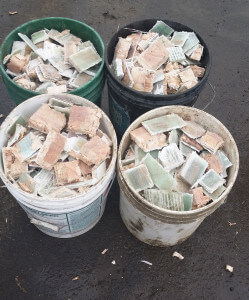
Old turbine blades are cut down to palm-sized pieces so that WSU researchers can refine and process them into new composite materials.
Currently, Germany maintains the world’s only industrial-scale factory for reprocessing wind turbine blades. Much like the researchers at WSU, this facility chops old blades up into chunks but then shreds and hammers them into fragments which are mixed in with other wet waste material and used as fuel at a cement-making factory.
Retired blades have also been re-conditioned for second-hand use into smaller community turbines.
Wind turbine owners could also hit up the Internet and, much like one might sell a computer or camera on eBay, try an online marketplace for selling used turbine parts. For example, Spares in Motion markets itself as “the e-business platform for the wind-turbine aftermarket.” A quick search for “turbine blades” on their site found a listing for blades as old as 1997.
So what’s the most promising advice to follow for an aging wind fleet and good ol’ wind turbine blades? There probably isn’t just one. It depends on the turbine, owner, country, and available resources.
Perhaps there is no “one size fits all” answer to dealing with retired turbine blades but a step in the right direction is one outside of a landfill.
Filed Under: Blades

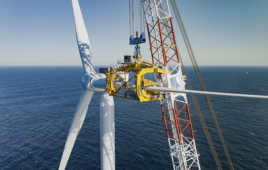
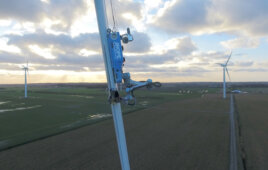


Use the thinner portions of the blades for a border fence. Cut the blades into suitable lengths, stand them vertically, side by side with the ends set in concrete. Mix and match blade profiles to get the most efficient fit between sections. Cap the cut ends with concrete.
They should outlast steel, be much harder to climb, more difficult to cut through with portable power saws or torches. They can be cut (slowly) with abrasive wire saws on sites where the blades are laid on the ground. Once set up and started, such saws operate without attention and stop automatically when the cut is finished.
Other possible uses for the larger, hollow ends. sea walls, erosion stops, pier or dock pilings, culverts that never rust.
Make some available to the public and watch what happens.